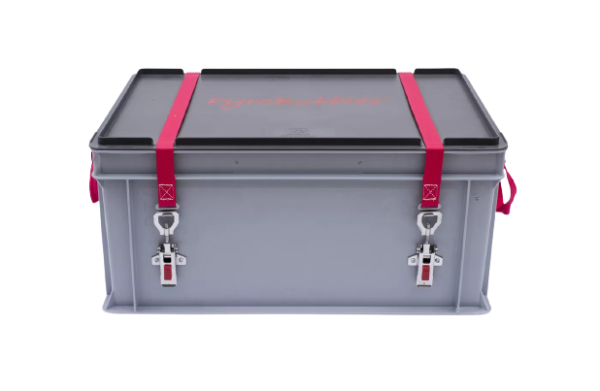incl. VAT.
Please note: Notes on delivery time
Free shipping (Germany, mainland)!
Shippingtime: 1-2 weeks
- Article no: GENVG2SB1BS

Questions about the article?
Our staff member Petra Fürbeck is happy to help you:
+49 (0) 7151 - 256 4817 or info@lion-care.com
| max. gross mass: | 45 kg |
| Max. Battery size: | 496 x 296 x 216 mm |
| Empty weight: | 3.5 kg |
| max. net dangerous goods mass: | 32.5 kg |
| Handling the filling material: | Filling material in cushions |
| Material name: | Polypropylene (PP) |
| Volume: | 47 l |
| Packaging group: | Packaging group II |
| Packaging instructions according to ADR: | PI 903, PI 908, PI 909, PI 910 |
| ADR special provision: | SP 310, SP 376, SP 377 |
| UN packaging code: | UN 4H2/X30/S/yy/B/UTZ-000015, UN 4H2/Y45/S/yy/B/UTZ-000015 |
| Areas of application: | E-bike batteries, Model batteries, Garden tool batteries, Prototypes, Power tool batteries |
| External dimensions: | 600 x 400 x 293 mm |
| Filling material: | PyroBubbles® |
| Internal dimensions: | 558 x 358 x 235 mm |
The Lio Guard S-Box 1 Basic plastic transport container presented here is the ideal solution for users who are looking for a reliable way to transport or store lithium batteries / lithium-ion batteries with substance numbers UN3090, UN3091, UN3480, UN3481 in compliance with the latest standards. In addition to the storage of intact lithium batteries, the Lio Guard S-Box 1 Basic transport container is particularly suitable for damaged cells, which represent a significant source of danger both during transportation and storage. The plastic containers in the Lio Guard series are ideal for applications such as e-bike batteries, power tools and laptops that use lithium-ion batteries.
Size and capacity of the battery transport container
The Lio Guard S-Box 1 Basic transport container has a volume of 47 liters and can hold a hazardous goods quantity of 32.5 kg with a maximum size of 496 x 296 x 216 mm. The empty weight is 3.5 kg, with a maximum gross weight of 45 kg. This is the smaller of two versions in the S series of Lio Guard plastic transport containers.
The battery container is extremely handy and flexible to use. With external dimensions of 600 x 400 x 293 mm and internal dimensions of 558 x 358 x 235 mm (length x width x height), the Lio Guard S-Box 1 Basic transport and storage container is compact and therefore ideal for applications in restricted environments. In addition, the boxes are stackable and therefore take up minimal storage space. The container is made of robust polypropylene and can be used in a temperature range of -20°C to 80°C. It should be stored between 15°C and 30°C. It should be stored between 15°C and 30°C. According to experience with commercially available and everyday lithium-ion batteries, the total capacity of all batteries stored in the GENIUS S-Box 1 Basic should not exceed 1.0 kWh in total.
A coordinated system through the use of PyroBubbles®
Individual and expensive transport solutions can be replaced by using this economical and standardized product. The boxes are permanently reusable and are available in Basic, Advanced and Premium versions. The box is filled with the fire protection agent PyroBubbles®, which forms a closed and thermally insulating layer around a fire source. This version of the box comes with 45 small PE filling pads, each weighing 0.22 kg (0.70 liters). The cushions are surrounded by thin, needled polyethylene (PE) film, which dissolves in the event of a fire and can thus release the extinguishing agent. Tensioning straps with quick-release fasteners ensure that the lid remains closed. Even in the event of a chain reaction (thermal runaway), the surrounding area is reliably protected.
Certification and guidelines
Lithium batteries fall into dangerous goods class 9, which means that the goods pose a risk to the environment during transportation that should not be underestimated. Numerous specifications and guidelines must therefore be observed when transporting lithium batteries. The transport boxes in the Lio Guard series have been specially designed to meet the strictest safety regulations.
Certified for packaging group II
The containers in the Lio Guard series meet the requirements of packaging group II, which means that substances with a medium hazard potential may be transported in them. To achieve this classification, the box must be type-tested and withstand a drop height of 1.2 m.
Suitable for transportation in accordance with SV 376 of the ADR and packing instruction P 908
All lithium-ion cells or batteries and lithium-metal cells or batteries that have been damaged and no longer comply with the applicable regulations according to their manual must comply with the provisions of Special Provision 376 (SV 376). This applies, for example, to cells that have leaked or degassed, have suffered external or mechanical damage or have been identified as defective for safety reasons or could no longer be diagnosed prior to transportation. These cells must then be packed in accordance with packing instruction P 908. According to this directive, for example, it must be ensured that any electrolytes released are absorbed and a non-electrically conductive thermal insulation material must ensure that the environment is protected from dangerous heat generation.
For storage, transportation and recycling in accordance with SV 377 of the ADR and packaging instruction P 909
Special provision SV 377 regulates the transportation of lithium-ion cells or batteries and lithium-metal cells or batteries that are transported for disposal or recycling. Similar to packing instruction P 908, guidelines for packing group II must be observed in P 909. In addition, restrictions on the nominal energy and weight of the lithium-ion cells and batteries apply.
Prototype transports according to SV 310 of the ADR and packing instruction P 910
The special provision SV 310 regulates the transportation of prototypes of lithium-ion cells or batteries and lithium-metal cells or batteries. Packaging instruction P 910 then specifies, among other things, requirements for packaging and the mass of dangerous goods.
VdS 3103 : 2019-06 (03) - Lithium batteries
To date, there are no legal requirements for the storage and provision of lithium batteries in public areas.
The following publication provides recommendations for preventing damage when providing lithium batteries in production and storage areas. It describes the most important findings from fire tests on the subject of storage and provision.
Click here to access the publication of the German insurers (GDV e.V.) on loss prevention
Future-oriented
Lithium-ion batteries will be indispensable in all industrial applications in the coming years. However, if used improperly, batteries can pose a potential risk during production, storage and transportation that should not be underestimated. By purchasing these boxes, you protect yourself against major financial losses right from the start. International customers from the automotive and energy supply sectors, among others, rely on this proven technology.
In use for you
If you have any questions, please do not hesitate to contact us. We look forward to hearing from you!
| Suitable for critically defective?: | No |
| max. gross mass: | 45 kg |
| Max. Battery size: | 496 x 296 x 216 mm |
| Empty weight: | 3.5 kg |
| Type: | Storage box |
| Material: | Plastic |
| Type of packaging: | Dangerous goods packaging < 450 liters or < 400 kg net |
| Volume: | 0 - 84 l |
| max. net dangerous goods mass: | 32.5 kg |
| Handling the filling material: | Filling material in cushions |
| Filling material supplied: | PyroBubbles® (Füllkissen) |
| Coding: | 4H2 |
| Material name: | Polypropylene (PP) |
| Volume: | 47 l |
| Packaging group: | Packaging group II |
| Packaging instructions according to ADR: | PI 903, PI 908, PI 909, PI 910 |
| ADR special provision: | SP 310, SP 376, SP 377 |
| UN packaging code: | UN 4H2/X30/S/yy/B/UTZ-000015, UN 4H2/Y45/S/yy/B/UTZ-000015 |
| Areas of application: | E-bike batteries, Model batteries, Garden tool batteries, Prototypes, Power tool batteries |
| External dimensions: | 600 x 400 x 293 mm |
| Filling material: | PyroBubbles® |
| Internal dimensions: | 558 x 358 x 235 mm |
Real fire test with 2x LiPo batteries 5000 mAh in the Lio Guard XS-Box Basic
real fire test with Pedelec battery 324 Wh in the Lio Guard XS-Box Basic
That depends on various factors that need to be considered:
- size of the battery(ies)
- condition (e.g. non-critical, defective, critically defective or prototype)
- power
Transport boxes are available in many different sizes and specifications. The packaging group for which the box is suitable is indicated for each product.
Find out more in our blog article:
https://www.lion-care.com/aktuelles/blog/transportvorschriften-regeln-und-sicherheitsmassnahmen
Even if the batteries are not critical, remember to protect them from shocks and to order appropriate filling material if it is not already included in the box.
Yes. Should a battery reach a critical state and cause a fire, separating the batteries will prevent the fire from spreading and multiplying.
Generally, the insulation and protection material should line all sides of the container. The batteries are stored between individual layers.
We also have containers in our program that already have the protective material integrated into the outer wall. No further protective layer is necessary here.
The technical principles for storage and transportation solutions are very similar. The transport boxes are also subjected to extensive tests in accordance with ADR (drop test, fire test, etc.) to confirm compliance with the ADR regulations. The packaging regulations are extensive and regulated by law.
There are currently no comparable regulations for storage. Nevertheless, manufacturers of storage boxes regularly carry out appropriate tests.
The right container depends on the type and size of the battery to be shipped or stored.
If you want to learn more about battery storage and transportation, you will find the answers in our blog articles:
https://www.lion-care.com/aktuelles/blog/transportvorschriften-regeln-und-sicherheitsmassnahmen
https://www.lion-care.com/aktuelles/blog/lithium-ionen-akkus-sicherer-umgang-und-richtige-lagerung
The transportation of batteries is subject to ADR regulations.
The number, size and weight, energy density and condition of the batteries are crucial parameters for finding a suitable transport container for lithium-ion batteries. The selection process is complex and should be carried out by appropriately trained personnel. We have a trained hazardous materials officer on our team. Please feel free to contact us.
Plastic containers are cheaper but not as durable as metal containers. They are suitable, for example, for non-critical batteries, defective batteries, prototypes and end-of-life batteries. They can be used for both storage and transportation.
Metal containers are required, for example, when dealing with critically defective batteries.
The exact packaging instructions for these cases can be found in the ADR or by consulting a certified hazardous materials specialist.
To date, there are no legal requirements for the storage of lithium-ion batteries, which does not mean that they should be stored without suitable protective measures.
It is best to check with your insurer to find out which measures they recognize as suitable in the event of a claim.
For example, a suitable box could already be recognized as spatial separation.
A rough overview can be found in this VDS publication from the GDV:
https://shop. vds.de/download/vds-3103/ccb1d439-ad9d-47cb-a2b1-ace23e155610
Please also read our blog article on this topic:
https://www.lion-care.com/aktuelles/blog/lithium-ionen-akkus-sicherer-umgang-und-richtige-lagerung











